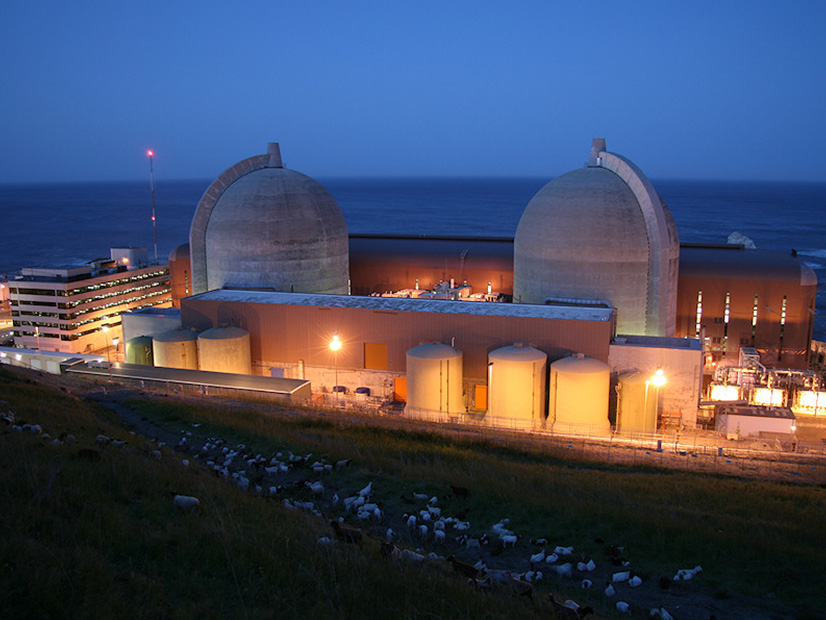
The planned closure of California's last nuclear plant at Diablo Canyon is prompting reliability concerns.
| PGEIn two workshops Monday, the California Energy Commission examined the role of natural gas in the energy mix through the middle of this decade as the state’s last nuclear plant retires, older gas plants close and the grid relies more heavily on renewables and storage.
In the morning session, CEC commissioners and analysts addressed the question of whether the state needs additional thermal generation, including incremental boosts to existing gas plants, to meet reliability challenges from 2022 to 2026.
The short answer was ‘no’ but with caveats and contingencies.
Hotter summers with strained supply make conditions more difficult to predict, lead Commissioner Siva Gunda said. Last summer’s rolling blackouts and this summer’s near misses are examples, he said.
“As we have seen last year and this year, heat waves and droughts are posing much more substantial impacts on demand and supply,” Gunda said. “This makes a look ahead much more challenging.”
California has experienced problems during Western heat waves in the evening hours, when solar ramped down and imports dried up.
“How do we plan for contingencies in the extreme events that might be significantly beyond [traditional] planning assumptions?” Gunda said. “As most of us know, the critical issue to address in the midterm is really the reliability during the net peak time that offers both ramping and dispatch uncertainties.”
“This workshop is a first step to frame the question and develop a dialogue around this important question in an open, transparent and robust way,” he said.
California Public Utilities Commissioner Clifford Rechtschaffen noted that the CPUC’s decision to order utilities to procure an additional 11.5 GW by mid-decade “teed up” the issue but skipped the question of whether more gas generation might be needed. (See CPUC Orders Additional 11.5 GW but No Gas.)
“We left open in that ruling whether and to what extent we should authorize procurement from any natural gas resources pending further review, including this analysis from the Energy Commission,” Rechtschaffen said. “So while we’re here today, the work will help inform that decision whether there’s a need for additional procurement for reliability through 2026, and whether any fossil resources should be should be considered.”
No More Gas Needed, Probably
To answer those questions, CEC staff members broke down their analysis into several tracks, said Liz Gill, adviser to Gunda. The first track dealt with a technical analysis evaluating midterm capacity needs and evaluating thermal capacity needs.
Do “incremental thermal resources provide an additional reliability benefit compared to a portfolio of preferred resources [mainly renewables and storage]?” Gill said.
The CEC’s demand forecasts informed the analysis. In the second of Monday’s workshops, CEC staff looked at expected gas demand through 2035. Pacific Gas and Electric and Southern California Gas, the state’s two largest suppliers, each predict a 1% decline in the next 14 years, though extreme weather could alter that forecast, the utilities said.
More importantly, the CEC’s examination considered the expected rollout of thousands of megawatts of battery storage in the coming years.
The state went from having 126 MW of battery capacity last year to 1 GW this summer, CEC staff said. More than 10 GW may eventually be connected to the ISO’s grid.
The CEC looked at the potential problems of that rollout, which has already included delays in the supply chain and booked-up manufacturers.
“And so, [we] asked, what are the potential risks with battery deployment and performance?” Gill said. That evaluation is ongoing.
The CEC’s Mark Kootstra presented the technical analysis, which concluded that summer 2022 remains a problem.
An emergency declaration by Gov. Gavin Newsom earlier this year cited a potential 5,000 MW capacity shortfall next year. (Calif. Governor Proclaims Emergency as Blackouts Loom.)
After that however, the state should be in better shape as more renewables and storage connect to the grid. By the end of 2022, about 5,000 to 6,000 MW of nameplate capacity resources are scheduled to come online, he said.
“Assuming we haven’t had any gas retirements beyond what’s considered in the analysis, the preferred system plan significantly diminishes the concerns for reliability from 2022 through 2026,” he said. The CPUC’s procurement orders “should be sufficient to diminish that reliability concern from 2023 on.”
He warned that unexpected contingencies could arise as they did in last summer’s heat waves and this year when a wildfire derated a major transmission line from the Pacific Northwest. (See CAISO Declares Emergency as Fire Derates Major Tx Lines.)
“We’re not out of the woods,” Kootstra said. “There could still be … contingencies. But I think overall, the planning is in good shape.”


